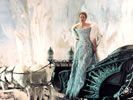Eye For Film >> Movies >> The Chronicles of Narnia: The Lion, the Witch and the Wardrobe (2005) Film Review
The Chronicles of Narnia: The Lion, the Witch and the Wardrobe
Reviewed by: Angus Wolfe Murray

The kingdom of Narnia is in the mind. It is also on the other side of the wardrobe, as Lucy said, but the others didn't believe her. Why should they? She's the youngest.
Peter, Susan, Edmund and Lucy are sent away from London during the war, like so many other children, to avoid the bombing, and end up in a vast pile, inhabited by a housekeeper, servants we don't see and a shy professor who CANNOT be disturbed.

The children have the run of the house, as long as they don't break anything. It is during a game of hide-and-seek that Lucy enters the wardrobe and discovers a snow-covered forest behind the layers of hanging fur coats, AS IF BY MAGIC.
This forest and the land beyond have been stuck in winter for 100 years and are ruled by a beautiful, wicked white witch, with the help of beasts of every description, wolves that act like storm troopers and insidious informers - it is rumoured that even the trees are a grass.
The animals talk and some, like the friendly beavers, are bigger than in the outside world. There are elves and centaurs and unicorns and mermaids and flying lynxes and all shapes of mythical things. There is good and there is evil. Soon, the good and evil will do battle, as happened in Heaven when the rebellious angel fell into the pit of doom and became Beelzebub, the great Satan. In Narnia, they talk of The Prophecy and the return of Aslan, The Chosen One, who, with the help of Peter and the others, will drive the white witch from the land forever.
What is so clever about this adaptation of C S Lewis's classic children's book is the avoidance of Disneyfication, despite being a Disney film, and the refusal to overload with CGI effects, as in the recent Star Wars prequels, in favour of character and plot. Also, it is remarkable, considering the New Zealand director (Andrew Adamson, last seen with Shrek 2), that the spirit and feel for the period IN ENGLAND remains entirely credible, even when transposed to the dream kingdom, where almost anything is possible.
It remains very much part of a child's imagination, unlike [film]The Lord Of The Rings[film] that is a real adventure within a country that genuinely exists for those who dare explore it, so that the creatures are never beyond belief and the details never entirely worked out - what does the ice palace look like inside? Where does Aslan's army come from?
The only weakness is Aslan himself, who appears, like Mufasa in The Lion King, already Wise & Wonderful, spouting aphorisms that will eventually be sewn onto cushions by pious spinsters. Other than being the embodiment of the Son of God, although it is never spelt out quite so boldly, he/it (the King of Beasts, you understand) has no discernable personality, other than being utterly butterly toasty.
The children behave in true sibling fashion, insulting each other, being foul, until disaster or a kidnapping occurs, when they rally round, lips astiffened. The performances are terrific, especially Georgie Henley as Lucy and Skandar Keynes as Edmund, the second youngest, aided, if not abetted, by an intelligent script that goes easy on the syrup, while remaining true to the dream.
Tilda Swinton's white witch is charming and dexterous and ruthless ("I have no interest in prisons. Kill them all!") and tyrannical, too sexy to be Stalin's daughter, too manipulative to be trusted with the promise of a secret. With this role, she reaches beyond the low budget, high-octane middle ground of well-received arthouse fare. No longer will she be remembered as Derek Jarman's favourite actress. Another kingdom beckons in a wood off Sunset.
Reviewed on: 09 Dec 2005



















